If you feel like you’re missing that spark of inspiration, go whale-watching with Peter Reading.
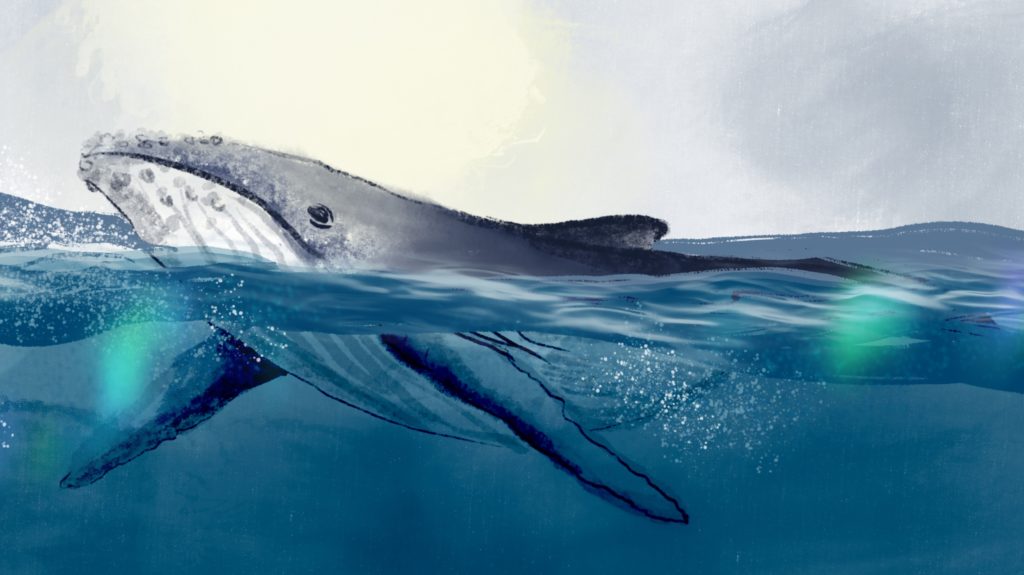
“He… delivered rare moments of epiphany, calm and wonder.”
Tim Dee (Writer, Radio Producer and Birdwatcher)
You might have to persist with today’s blog for a while. Because I’m going to tell you that Cetacean (meaning ‘a marine mammal such as a whale, dolphin or porpoise’), a poem describing a successful whale-watching trip, is not a poem about whale-watching. Wait – don’t give up on me just yet. Read the poem first and see for yourself:
Out of Fisherman’s Wharf, San Fransisco, Sunday, early,
our vessel, bow to stern, some sixty-three feet,
to observe Blue Whales – and we did, off the Farallones.
They were swimming slowly, and rose at a shallow angle
(they were grey as slate with white mottling, dorsals tiny and stubby,
with broad flat heads at least one quarter their overall body lengths).
They blew as soon as their heads began to break the surface.
The blows were as straight and slim as upright columns
rising to thirty feet in vertical props.
Then their heads disappeared underwater, and the lengthy, rolling
expanse of their backs hove into our view – about twenty feet longer
than the vessel herself.
And then the diminutive dorsals
showed briefly, after the blows had dispersed and the heads had
gone under.
Then they arched their backs, then arched their tail stocks ready
for diving.
Then the flukes were visible just before the creatures vanished,
slipping into the deep again, at a shallow angle.
There, what did I tell you? Definitely not a poem about whale-watching. Of course, I’m being a little flippant. On one hand the poem is absolutely about whales. There they are, swimming alongside the speaker’s boat, showing off their magnificent broad heads and even blowing water thirty feet in the air, as if to announce, “this poem is all about us, the whales.” The poet, Peter Reading even uses spatial form (the shape of the lines on the page) to mimic the outline of the whales’ bodies, and humorously replicate the way the whales are about twenty feet longer than the vessel herself, from which his speaker observes them:
Then their heads disappeared underwater, and the lengthy, rolling
expanse of their backs hove into our view – about twenty feet longer
than the vessel herself.
See how the first two lines are long? They represent the whales. The third line is short, and that’s the boat.
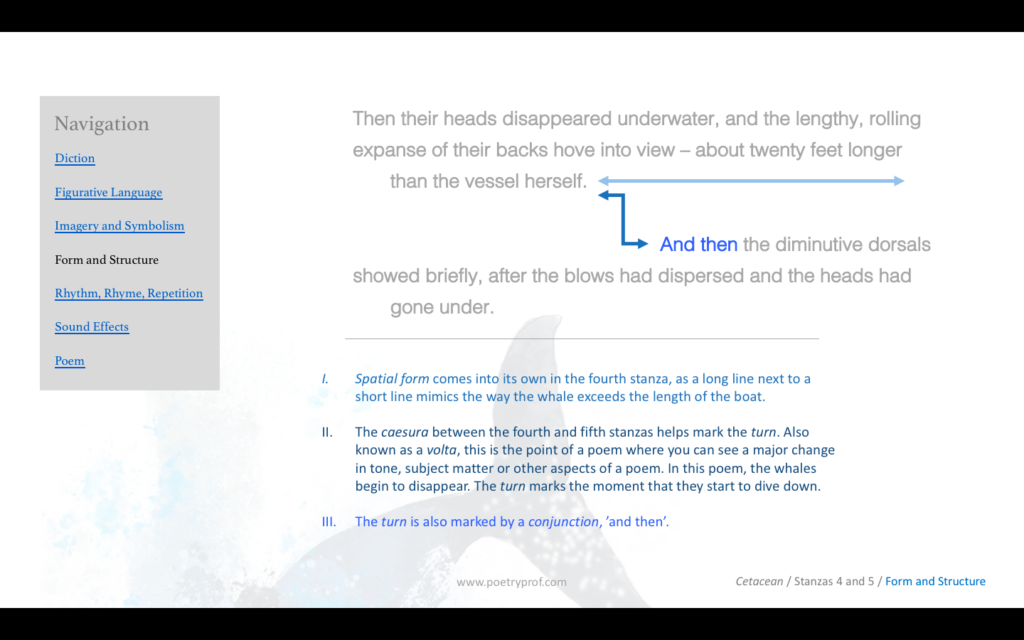
What I’m getting at with my assertion that Cetacean is not really about whales is: poems have topics, but they also have themes. People sometimes use these words interchangeably, but they are very different. The topic is what the poem is ostensibly about: in this case, whale-watching or the power of nature. Read other poems to encounter any number of topics: love, childhood, independence, changing seasons, space exploration, any of a thousand possible ‘big ideas.’ Unlike a topic, a theme is not transposable. There could be a thousand different poems on the topic of ‘love’, but each one of them would have a slightly different theme, a unique take that this particular poem, this writer, on this occasion has to say. If I read two of those poems about ‘love,’ the theme of Poem A might be ‘the grief one feels when love is unrequited marks one forever’ while the theme of Poem B might be ‘the way love at first sight turns your world upside down.’ When writing about themes in poetry, you may never write the same sentence twice.
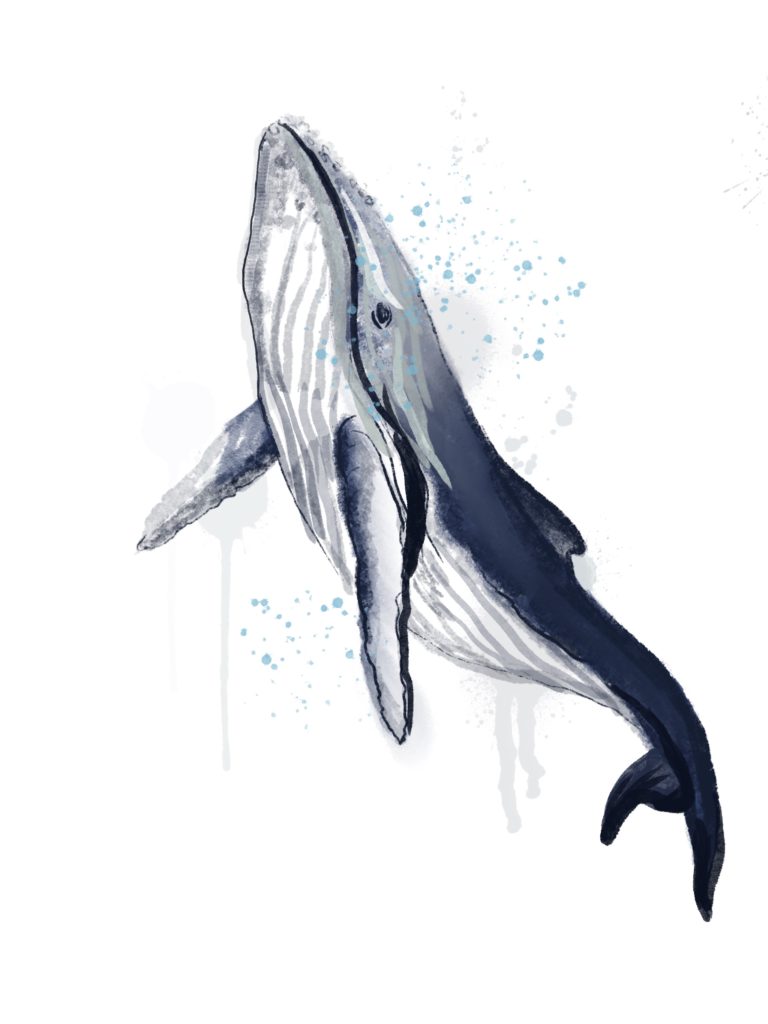
I hope I haven’t lost you so far. Poems, then, can be about more than one thing at the same time. That’s definitely true in Cetacean. On one hand this poem is straightforward, a lovely description of an encounter with the titular creatures while on a whale-watching trip off the coast of San Fransisco. You might say the theme is something to do with the lure of nature, and our need to explore, observe and connect – however briefly – with places and creatures not of our own kind or making. But on the other hand (and here’s where you’ll have to bear with me for a while) Reading’s poem is also about the difficulty of being a poet, the elusive nature of inspiration, and the way the imaginative, creative impulse when it finally strikes is huge, massive, overwhelming… but quickly fades, like a great whale slipping into the depths of the ocean.
How I might persuade you to agree with me is by showing you the stylistic contrast between stanzas one and two. Stanza one is written in a matter-of-fact way, almost like notes on the page. It’s presented as a list one might use to record events. Presenting a list using commas to separate items is called asyndeton and it creates a sparse effect, reducing the number of words while maximising the amount of information. The first lines are utilitarian, stripped of any meaningful description or ornamentation, possessing no richness or depth. Out of Fisherman’s Wharf, San Fransisco, Sunday, early… our vessel, sixty three feet communicates in snatches of language: names, places, times, dimensions. The first word of the poem (Out) makes me think of the phrase ‘got to get out of here’, as if he has no interest in his ordinary surroundings, or they don’t stimulate him any more; the Wharf, the city, the ‘ordinary’ world. The journey whizzes past, as if he’s eager to get to a place where something more special can happen. The poetic effects, slight though they are, all work towards that sense of speed; sibilance does a nice job of suggesting the boat slicing through the ocean waves; those commas help your eyes skip over the words towards the encounter ahead.
Then the speaker spots the whales. And look what happens to that note-taking style as soon as he does:
They were swimming slowly, and rose at a shallow angle
(they were grey as slate with white mottling, dorsals tiny and stubby,
with broad flat heads at least one quarter their overall body lengths).
Suddenly those snatches of language have transformed into flowing sentences, the commas all but vanish and instead enjambment (lines of poetry that flow one into the next with no break or pause) connects words together rather than fractures them apart. Alliteration becomes meaningful: swimming, slowly, shallow contains sibilant S conjuring the impression of sleek whales cutting through the water; and languorous, woozy W hints at the way the massive creatures ponderously roll over in the waves. From here on, the poem adopts it’s characteristic use of spatial form, offset lines tracing the approximate outline of whales complete with dorsals tiny and stubby protruding out from either end. (Poems that are written in the shape of an object are called concrete poems; Cetacean’s stanzas don’t quite reproduce the shape of a whale, but the impression is there nevertheless.) We begin to see visual imagery; colours and patterns (grey as slate with white mottling); shapes and sizes (tiny and stubby; broad flat heads) replete with descriptive adjectives and a simile (grey as slate) tucked away in there as well. On one level, it’s simply a lovely description of the whales. But on another, this encounter with wild nature has invigorated the speaker, unleashed his creativity and transformed his writing style. Gone are the scrappy notes and lists; the whales are the inspiration the speaker / poet needs to really write.
Throughout the poem there emerges a tension between this kind of ‘traditional’ poetic writing (involving imagery and figurative language) and a scientific or mathematical diction. Reading seems preoccupied with numbers: there’s a number in almost every stanza: sixty-three feet; one quarter; thirty-feet; twenty feet, even shallow angle. He also uses technical language – the precise names for whale parts: Cetacean, dorsals, flukes and stocks. Reading’s choice of register is unusual in this regard, and makes me think about how the the poetic and scientific ways of looking at the world don’t have to be mutually exclusive. There is a kind of beauty in pared back, direct and precise language and you might think about the implication that such an extraordinary natural spectacle doesn’t need much additional ornamentation. Whatever the reason for his choice, Cetacean might also appeal to readers who are sometimes put off by more ‘typical’ poetry.
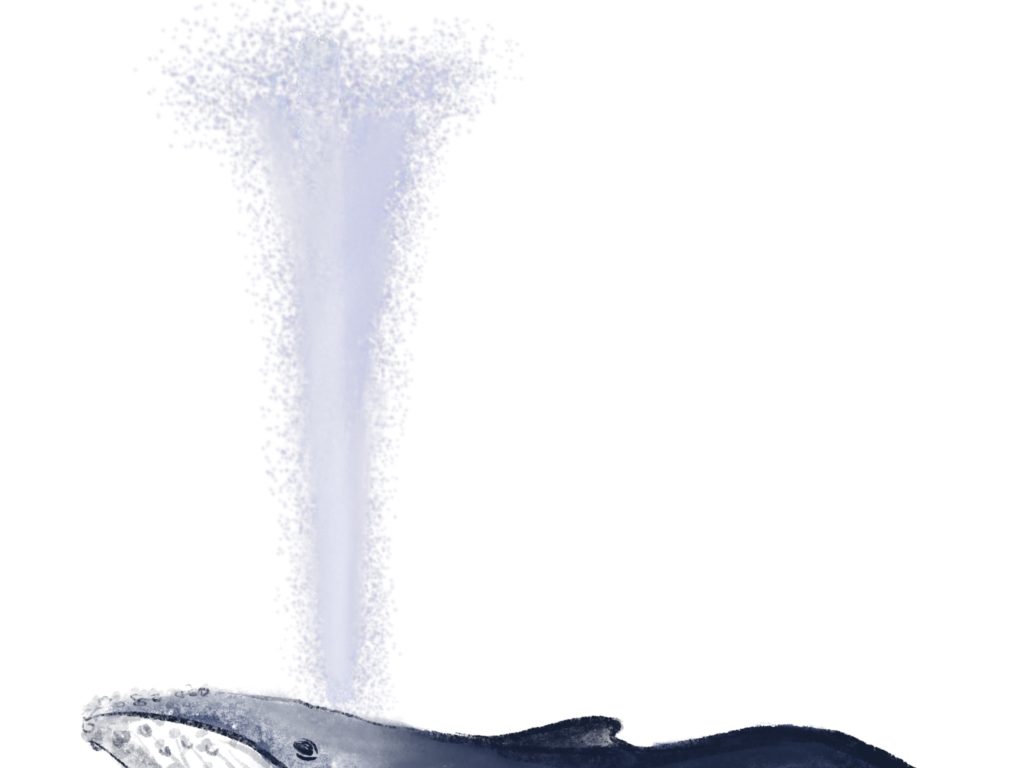
Stanza three is all about the blows, which are the characteristic jets of water whales expel as they breathe. Straight and slim as upright columns rising gives us sibilance again, the S sound mimicking the exhalation of seawater and spray from the blowhole atop the whales’ heads, and plosive B (blew, began to break, blows) creates for us the explosive sound of air. Thematically, it’s like a release of pressure which associates with the writer breaking through a creative block and seeing his poetry ‘shoot out’ onto the page. At the end of the stanza you’ll see another figurative comparison, a metaphor this time, expressed in scientific (or architectural) language. Upright columns of water are described as vertical props, meaning struts or supports. There’s nothing up there but sky, suggesting either that the columns of water are holding it up – or that they ‘support’ the writer’s mind as he practices his imaginative craft.
The whales’ impressive size is conveyed in the fourth stanza. Diction like lengthy, expanse and longer all emphasize how large they are; rolling and hove are verbs that suggest the momentum of a sizeable object when it moves. If you’ve stuck with me this far, you may agree that on another level the words explore the ‘feel’ of an outpouring of creativity. Writing well has its own kind of momentum, its own weight and ‘size’. The speaker is discovering that the power of the creative impulse, once unlocked by this encounter, is overwhelming. We haven’t used the word symbol yet, but this is what symbolism is: the use of a concrete object that you can see, hear and touch – like a whale – to represent an abstract idea (like ‘creativity’ or ‘imagination’).
If the shape of the lines on the page mimic the whales’ bodies, the structure of the poem conveys the movement of the whales as they breach, arch their backs, and dive back down into the ocean: the first four stanzas bring the whales closer; the last three have the whales receding. Traditionally, there often comes a moment in a poem where it shifts direction, changes tone, or alters course in some other way. This ‘change’ is known as a turn or volta. The volta can be marked by a physical break on the page called a caesura, which you can clearly see in the staggered white space between stanzas four and five. Just to be sure, a connective And then also marks the turn in Cetacean, the moment when the whales re-enter the water and swim away. The change is presented by contrasting language: after the turn diminutive (meaning ‘small’) replaces expanse and words from the lexical field of ‘vanishing’ (dispersed, disappearing, gone under) replace showed and observe. The way the whales recede is reminiscent of the mercurial nature of inspiration as well: when gripped by the creative impulse, the writer writes feverishly; but this only lasts for a certain time before clarity starts to fade.
The beauty of the writing at this part of the poem is a fitting tribute to the Blue Whales, nature’s largest living creature and one of the wonders of the ocean. Reading the poem, you get a sense that Reading was definitely struck and moved at seeing these magnificent creatures so close. For example, alliteration (diminutive dorsals, disappearing, dispersed) suggests to me the poem was crafted with love and care; the inspirational power of the whales helped the writer to write powerfully and well. The use of precise, technical diction such as dorsals, cetacean and, later, stocks and flukes implies a close, intimate knowledge of the whales’ bodies. Part of this knowledge is an appreciation of their enigmatic beauty; how such large creatures are at the same time so ephemeral. Internal rhyme (the poem has no rhyme scheme, but Reading ‘hides’ half-rhymes inside and between stanzas instead of at the end of lines) points to this idea: dorsals/overall, stern/Farallones, thirty/vertical, vessel/dorsal, showed/blows, backs/stocks are words that have tantalising similarities, as if you can almost – but not quite – hear the rhyming sounds resolve in your ear.
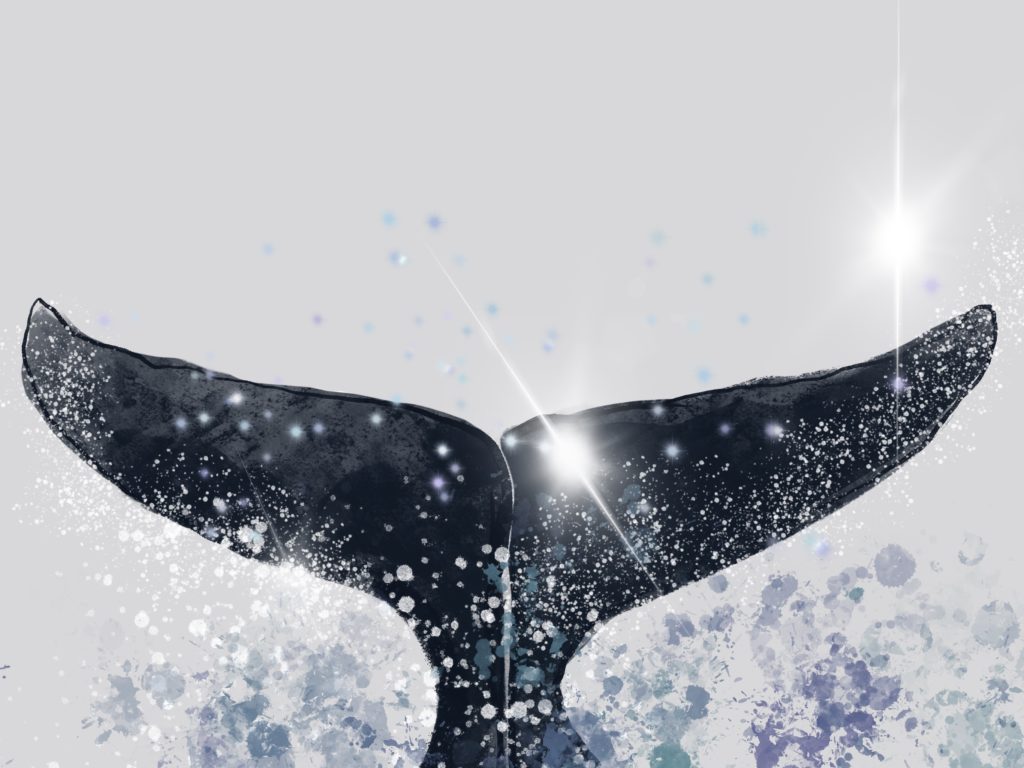
Before they disappear, Reading gives us one more moment to enjoy with the whales. Time seems to slow down, the whales’ arched bodies seem suspended, motionless, an effect created by repetition as well as the use of the words ready and just before. Then, the creatures vanished as if they were never there. The whales, like a poet’s creative inspiration, are huge and powerful – but gone in an instant. The characteristic shape of their forked tails (stocks; flukes) are the last thing to go.
The final words of the poem leave us with one last image: the whales slipping away at a shallow angle. There seems to be a contradiction in the final stanza: the whales both vanish into the deep again and, at the same time, disappear at a shallow angle. Juxtaposing these two descriptions is something of an oxymoron. Surely they cannot do both. Again, thinking of the whales as being symbolic of the writer’s inspiration and imagination helps resolve this contradiction. The words a writer needs to complete his poem are somewhere ‘below the surface’ of his consciousness. Sometimes they seem hidden away in the deep and summoning them up is an impossible task. At other times he can feel the right words just below the surface. When he is seized by the right inspiration the words expose themselves, rise to the surface and roll over in plain view. At a shallow angle also faintly evokes an image of the writer, now he’s come to the end of his poem, laying down his pen across a writing desk.
Despite their impressive largeness, the speaker never sees the whales in their entirety. As they swim close to the boat only one part is visible at any one time: a broad head; an expanse of back, the diminutive dorsal fins, tail stocks. Think about how this experience may be similar to that of writing a poem: in this case, the poem would not leap, fully formed, into the writer’s mind. Instead, he might get glimpses of what he wants to say, flashes of poetry that let him work on the lines bit-by-bit. Only when it’s finished does the whole, complete poem become apparent. Alternatively, you might recognise the act of reading the poem yourself reflected in the fragmented descriptions of the whales; sometimes you glimpse this idea, at other times you understand that. But the full meaning of the poem never entirely surfaces, and you are left to piece together meaning from small clues and little ‘flashes’ of insight.
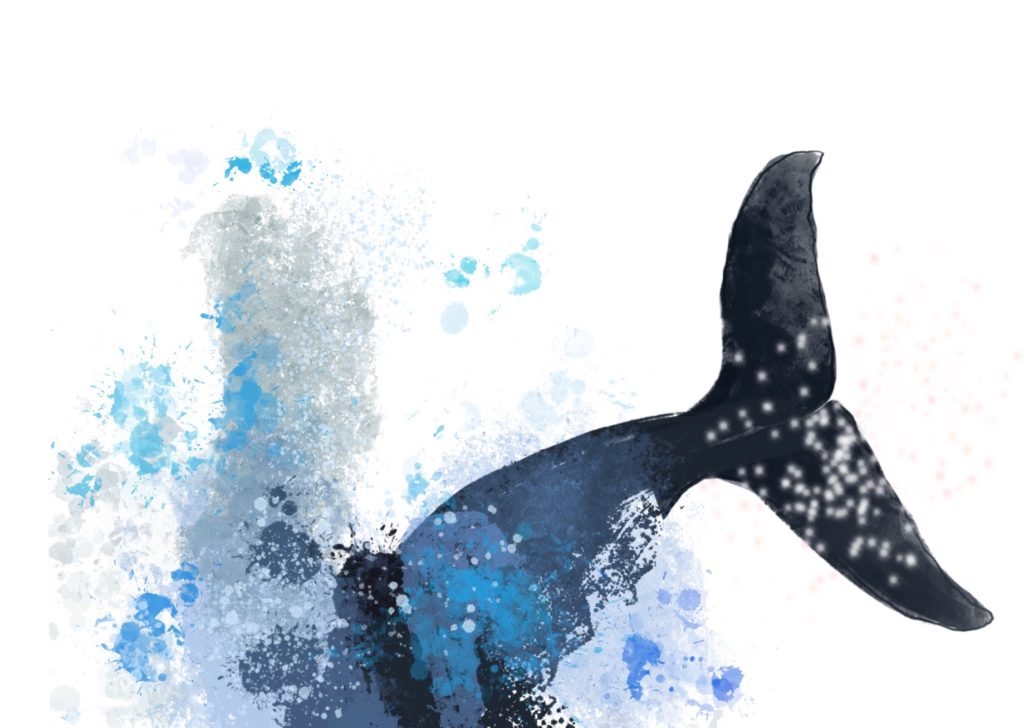
Suggested poems for comparison:
- The Thought-Fox by Ted Hughes
The master at writing symbolic animals, this poem is one of his most distinctive and memorable. A poet sits at his writing desk, struggling to put into words what he sees in his mind. That is until he contemplates a fox – and his poem runs out onto the page.
- The Fish by Elizabeth Bishop
In this poem, Bishop’s speaker is out on a fishing trip and hooks herself a gigantic and ancient fish. But as she looks into it’s eyes, and explores the wonders of its alien body, the speaker comes to realise the fish is so much more than just itself. The poem builds to a wondrous, euphoric climax – read it and see for yourself.
- Eyepiece by Judith Beverage
A poem from Australia, the speaker looks through a microscope and watches micro-organisms dance in the light. Like Cetacean, Beverage’s poem finds beauty in scientific descriptions.
Additional Resources
If you are teaching or studying Cetacean at school or college, or if you simply enjoyed this analysis of the poem and would like to discover more, you might like to purchase our bespoke study bundle for this poem. It’s only £2 and includes:
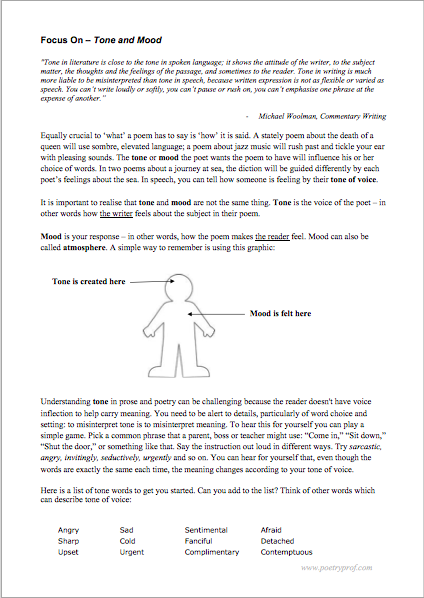
- 4 pages of activities that can be printed and folded into a booklet for use in class, at home, for self-study or revision.
- Study Questions with guidance for how to answer in full paragraphs.
- A sample Point, Evidence, Explanation paragraph for essay writing.
- An interactive and editable powerpoint, giving line-by-line analysis of all the poetic and technical features of the poem.
- An in-depth worksheet with a focus on explaining tone and mood in Reading’s poem.
- A fun crossword-quiz, perfect for a recap lesson or for revision.
- 4 practice Essay Questions – and one complete model Essay Plan.
And… discuss!
Did you enjoy this analysis of Cetacean? Do you agree that the whales can be associated with the power of inspiration or imagination? What do you find most effective about Reading’s descriptions of these magnificent creatures? If you have your own ideas about the poem, why not share them in the comment section below. And, for daily nuggets of analysis and all-new illustrations, don’t forget to find and follow Poetry Prof on Instagram.
thank you for these witty and quirky analyses, they help a lot, especially for the upcoming igcses!!
Man thanks a lot, you helped me for the IGCSE. Thanks again, it is so complete and great written !!
Hi Roxanne,
Thank you for your kind words; I’m very happy the blog helped you. Best of luck in your studies.
You’re work on poetry analysis has really proved helpful for IGCSE.
Thank you so much for the time and effort you put into writing your blog.
Please keep it up 👍
Thanks mate 🙂
No worries mate :o)
It was such a great read. So informative yet so interactive at the same time. Thank you for this!
Hi Lakshana,
I’m glad you enjoyed this breakdown. Thank you for your kind comment.
THANKS
But where in the poem is enjambment?
Hi Isaac,
Every time you see a sentence run from one line to the next without a break or pause, this is enjambment. For example:
And then the diminutive dorsals
showed briefly, after the blows had dispersed and the heads had
gone under.
Can you find other examples?